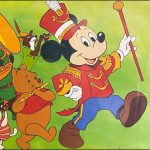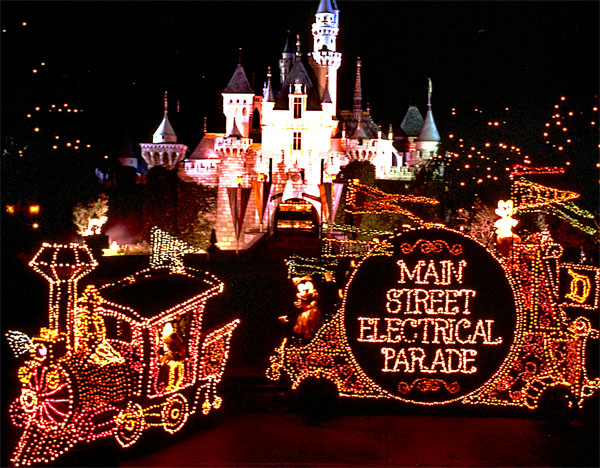


More examples of the vast number of recordings capturing the entertainment atmosphere permeating the Disneyland experience.

We continue our journey through a selection of Disneyland entertainment recordings with, as Ed Sullivan used to say, “something for the youngsters,” but certainly a treat for the grownups, especially as the event continued. Like the 1962 Wonderful World of Color episode, “Disneyland After Dark,” 1958’s “Date Nite at Disneyland” preserved some of the atmosphere of late fifties/early sixties dance parties at the original plaza location of Carnation Gardens.
The big band orchestras, which were still recording and touring, appeared regularly at Disneyland. Reportedly, Walt himself hosted a locally broadcast Disneyland dance show (Hollywood Squares host Peter Marshall hosted another series for the Disney Channel in the eighties). Some of the couples who danced there every week became regulars for decades. The record album is the only Disneyland record to open with a commercial jingle, as “Let’s Dance at Disneyland” was used extensively to promote the event. It’s a great example of advertising jingles of the period. The remainder of the album features the song stylings of Tony Paris.
In Walt Disney’s private office, there is a stereo system with a small library of LP records. One of them is the 1963 album, The Famous Ward Gospel Singers. This album was a big deal to Disneyland/Buena Vista Records because it involved the logistics of live recording at Disneyland by the in-house record company. Engineer/producer Bruce Botnick, whose albums include Mary Poppins, The Beach Boys’ Pet Sounds, The Doors’ first album, and Frozen, oversaw the transportation and installation of the equipment. The result is an exuberant, inspired listening experience that Walt kept in his record collection.
The Dapper Dans barbershop quartet made an appearance on a 1973 twelve-inch picture disc called A Musical Souvenir of Walt Disney World’s Magic Kingdom. One of the Dapper Dans, incidentally, was Ted Nichols, who became Hanna-Barbera’s musical director between 1964 and 1972 on such shows as Jonny Quest, Frankenstein Jr. and The Impossibles, The New Adventures of Huckleberry Finn, Scooby-Doo Where Are You? and Josie and the Pussycats (please read more about him in this keen book.)
The Mello Men (or Mellomen), heard in countless films and backing major singing stars, recorded a 1957 album called Meet Me Down on Main Street. The title song, composed by Oliver Wallace, was heard on Walt Disney Takes You to Disneyland and originated in the 1950 Donald Duck cartoon, Crazy Over Daisy. The Mello Men were founded by Thurl Ravenscroft, singing here with Bill Lee, Bob Stevens, and Max Smith:
There have been countless LPs, CDs, and downloads featuring musicians and vocalists who performed in Disney parks. Some of them, like Coke Corner ragtime pianist Rod Miller, have independently created their own discs. In the late sixties, a young musician named Richard Carpenter was among the Main Street pianists. He and his fellow children of the era wanted to sport the long hair that was popular but still unheard of in the days of “The Disney Look.” Carpenter became irritated by one particular member of management, Vic Guder. Few realized that “Mr. Guder,” one of the songs on The Carpenters’ first album, Close to You (1970), was a backhanded “salute” to Richard’s former boss. Years later, he regretted this acerbic product of his youthful rebellion.
Two albums celebrate New Year’s Eve at the Disneyland Resort, both produced independently. One is a dance band disc by Bernie Bernard and His Orchestra entitled New Year’s Eve at The Fabulous Disneyland Hotel.
The other album was supplied to radio stations to add to their holiday programming. 1967’s New Year’s Eve at Disneyland is a narrated “tour” of the park with various musical highlights by the Park performers. It’s sponsored by Pepsi-Cola, so the festivities pause occasionally to refresh with Pepsi commercials.
There have been many parade soundtracks in the last few decades (especially on the superb Tokyo Disneyland CDs). 1974’s Walt Disney Character Parade was captured on a flexi-disc (or sound sheet) sold on both coasts. The disc folded into a mailer to be used as a postcard (but I hope few used it that way as the slightest crease will destroy a flexi-disc). Thanks to Google, the hard-to decipher lyric, “you’ll hear laughs and shouts of joy as troubles fade,” is a revelation to many, as was “through the courtesy of Fred’s two feet” (oops, there’s that keen book again)!
One of the seventies’ most interesting Park processions was 1975’s America on Parade, a Disney Bicentennial salute. The parade featured historical figures with oversized heads, sort of Mardi Gras style, with Mickey, Donald and Goofy doing a live version of the “Spirit of ‘76” painting. The parade was quite a stylistic departure for Disneyland, and inspired merchandise including a commemorative book and this album, featuring the electronic musical score:
Nighttime extravaganzas have become a tradition at many Disney Parks, but one of the most beloved originated in 1972 as the Walt Disney World Electrical Water Pageant in Florida. The theme music, a 1968 instrumental called “Baroque Hoedown” by Jean Jacques Perrey and Gershon Kingsley (and can be heard briefly on this 1968 Beatles Fan Club Christmas record), turned out to be the perfect choice for the enduring theme. The pageant still exists, but it has been overshadowed by the Main Street Electrical Parade, which debuted at Disneyland later in 1972. Picture discs were released for both the Water Pageant and the Main Street Electrical Parade, the latter also appearing on the first Disney theme park music compilation LP, The Official Album of Disneyland/Walt Disney World, This collection was revised numerous times on vinyl and CD, most recently an ever-changing playlist that Disney provides to various streaming services.
One of the most successful follow-ups to the Electrical Parade was SpectroMagic, featuring a memorable theme by John Debney, now a major Hollywood composer who apprenticed with Hoyt Curtin at Hanna-Barbera (it’s in that keen book). The music was released on its own CD and in various compilations.
Disney Legend Barnette Ricci became a Disney cast member in the late sixties. She was a member of the Young Americans, who sang backup on The Ed Sullivan Show when Johnny Mathis performed “Chim Chim Cheree.” This broadcast, according to Disney Music Group founder Jimmy Johnson, had a role in earning the song an Oscar. On the 1965 Firestone Christmas album, they sang the stirring “Bells of Christmas” with Julie Andrews, conducted by Irwin Kostal.
Barnette was featured in the acclaimed documentary about the Young Americans, alongside a pre-Carol Burnett Show Vicki Lawrence. The film, which has aired on TCM, is a time capsule of fresh-faced young vocal groups that toured the world in sixties. Buena Vista’s 1968 Kids of the Kingdom album is also a time capsule, in which the peppy ensemble (Barnette included) sings standards, Disney hits, and some of the grooviest tunes of the day, like “I Dig Rock and Roll Music” and “What the World Needs Now.”
The Disneyland Band returned to vinyl in 1969 in an eponymous Buena Vista album comprised principally of new and classic Disney songs, including the theme to 1968’s The One & Only, Genuine, Original Family Band. Several tracks were re-released on a 1976 Disneyland album titled I Love a Parade. The title song of this album originated on the Kids of the Kingdom LP.
The crown jewel of Barnette Ricci’s 40-year Disney career is the script, direction and song (with Bruce Healey) for FANTASMIC!, still just as enchanting today as it was when it made its Disneyland debut in 1992. Like SpectroMagic, the soundtrack was sold in the parks and added to compilations.
Of course, this has been only a selection of recordings, not a comprehensive one, considering the Disney releases, limited editions, independent pressings, and promotional issues. What are among your favorites, and what others have you enjoyed over the years?